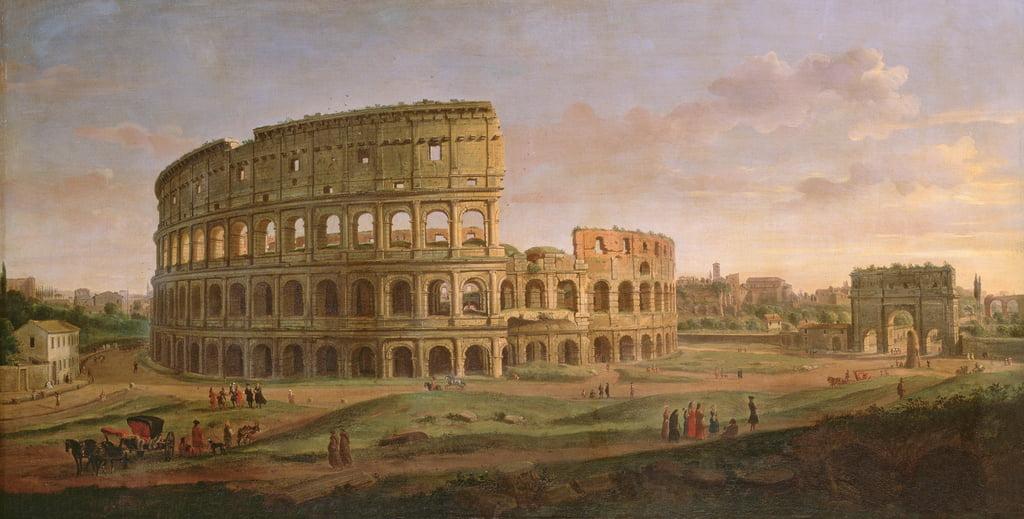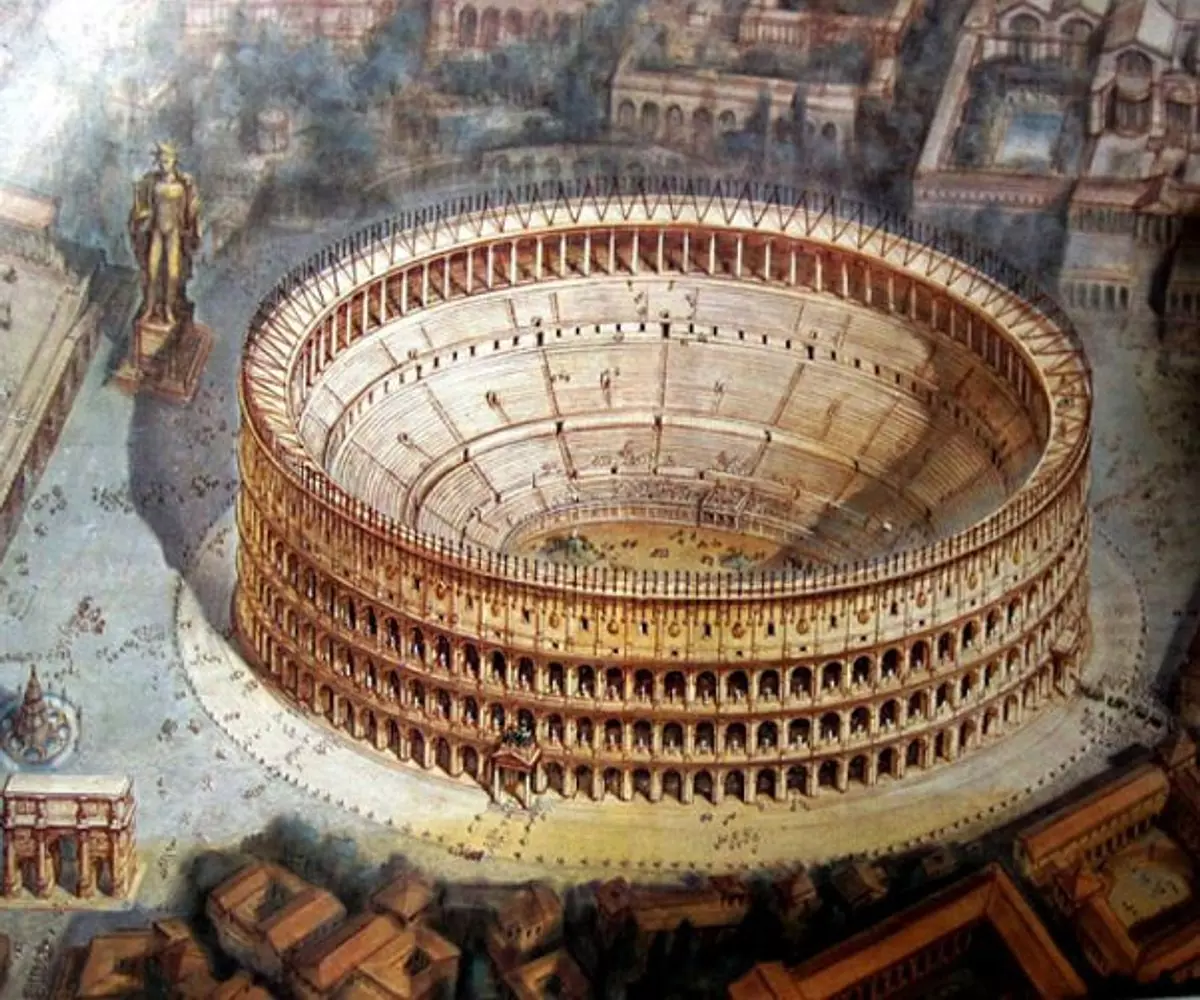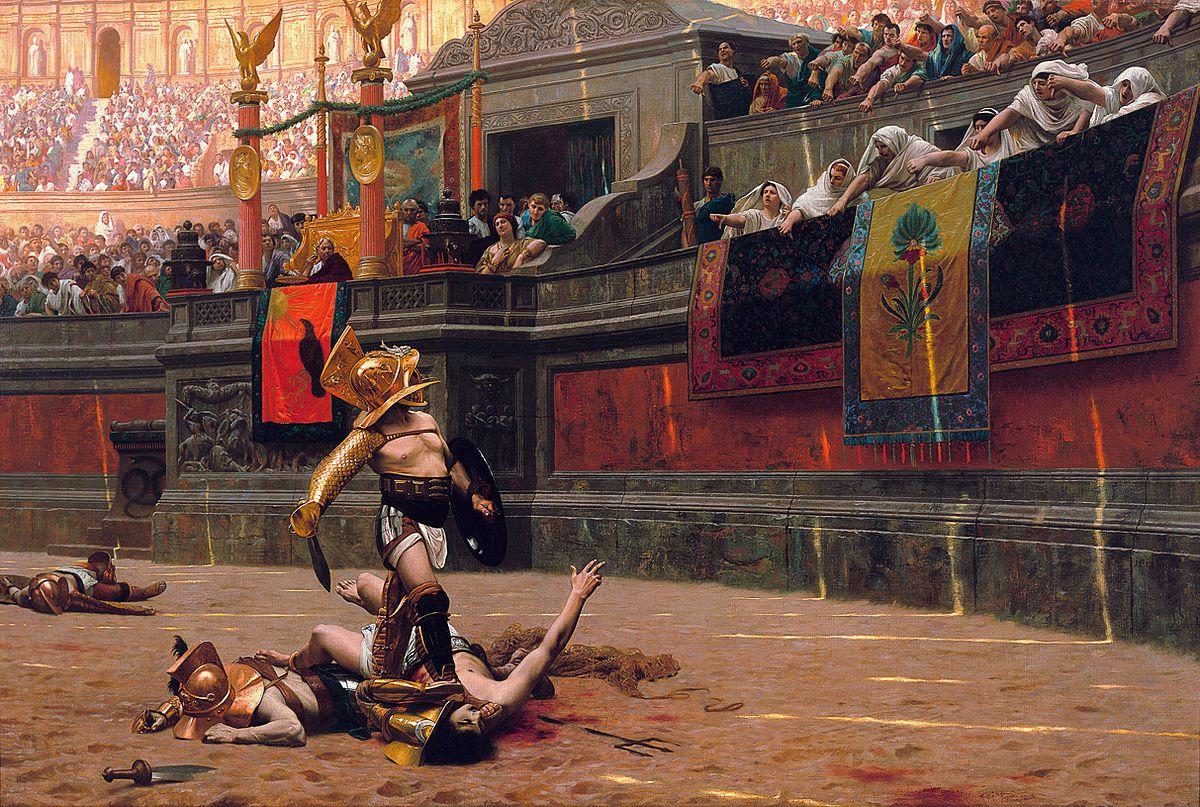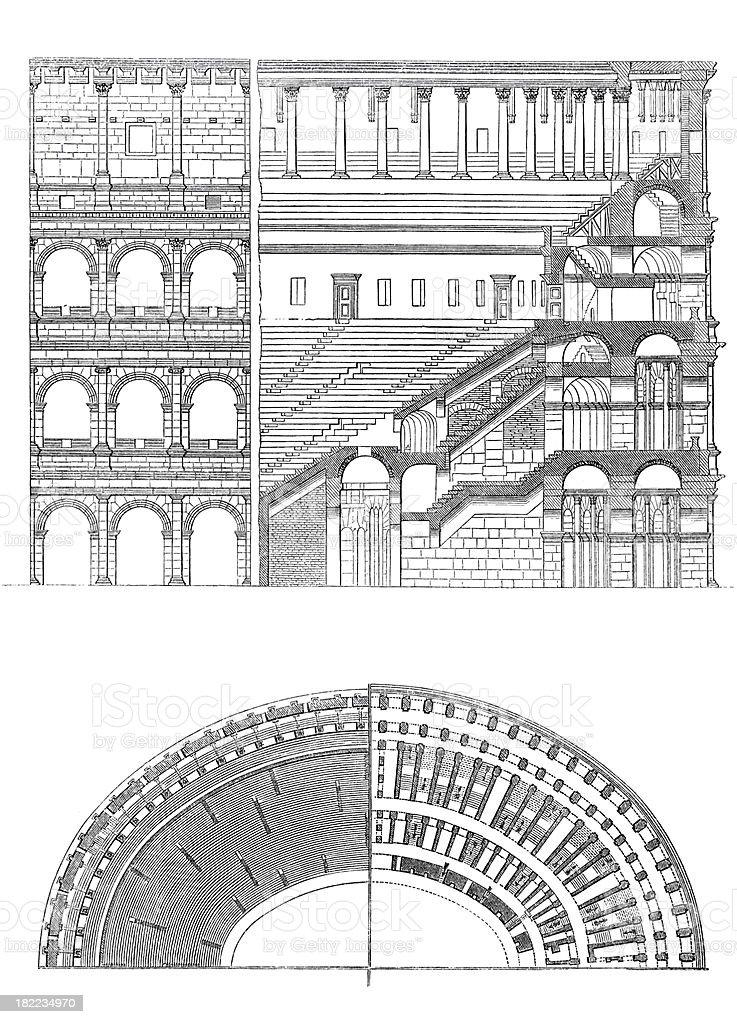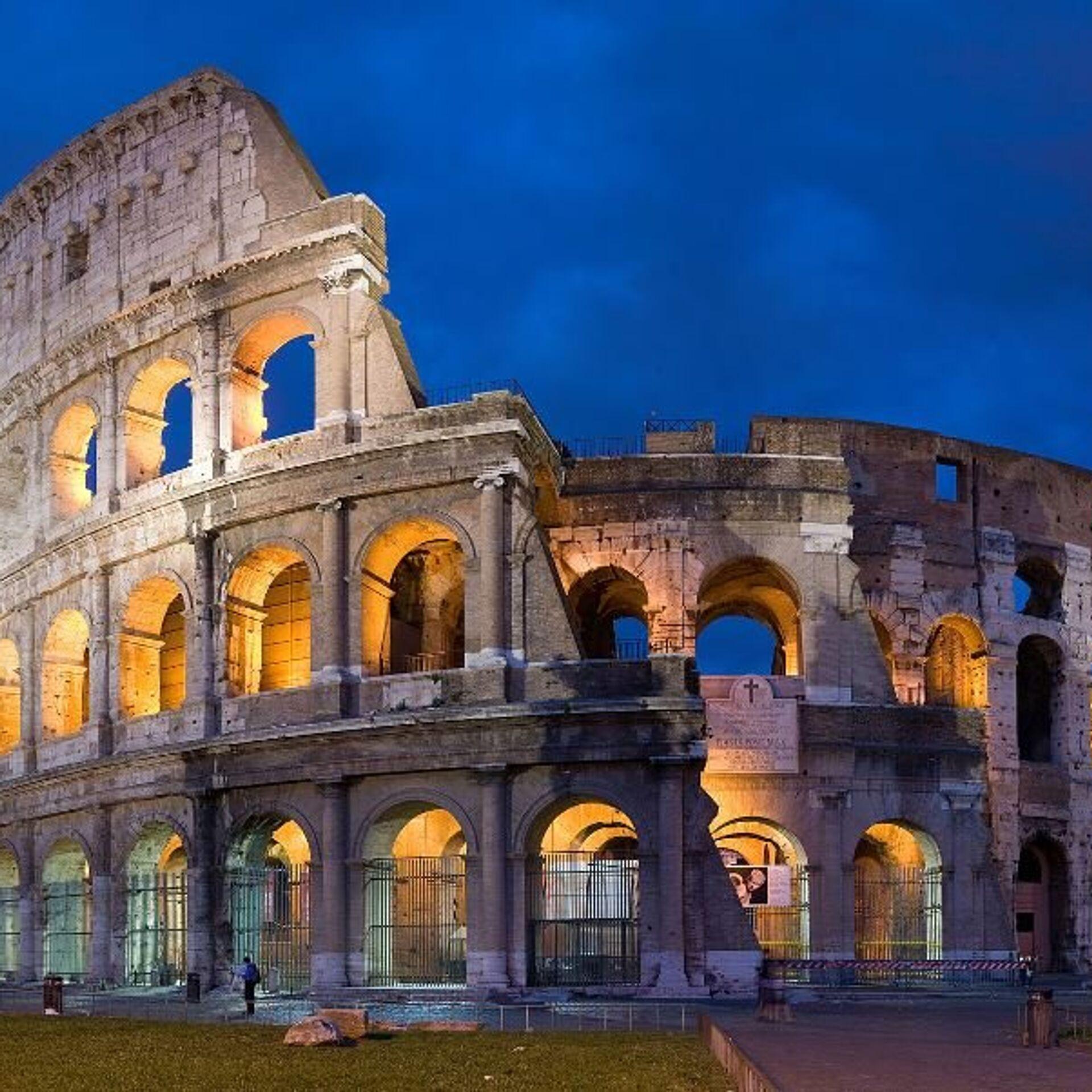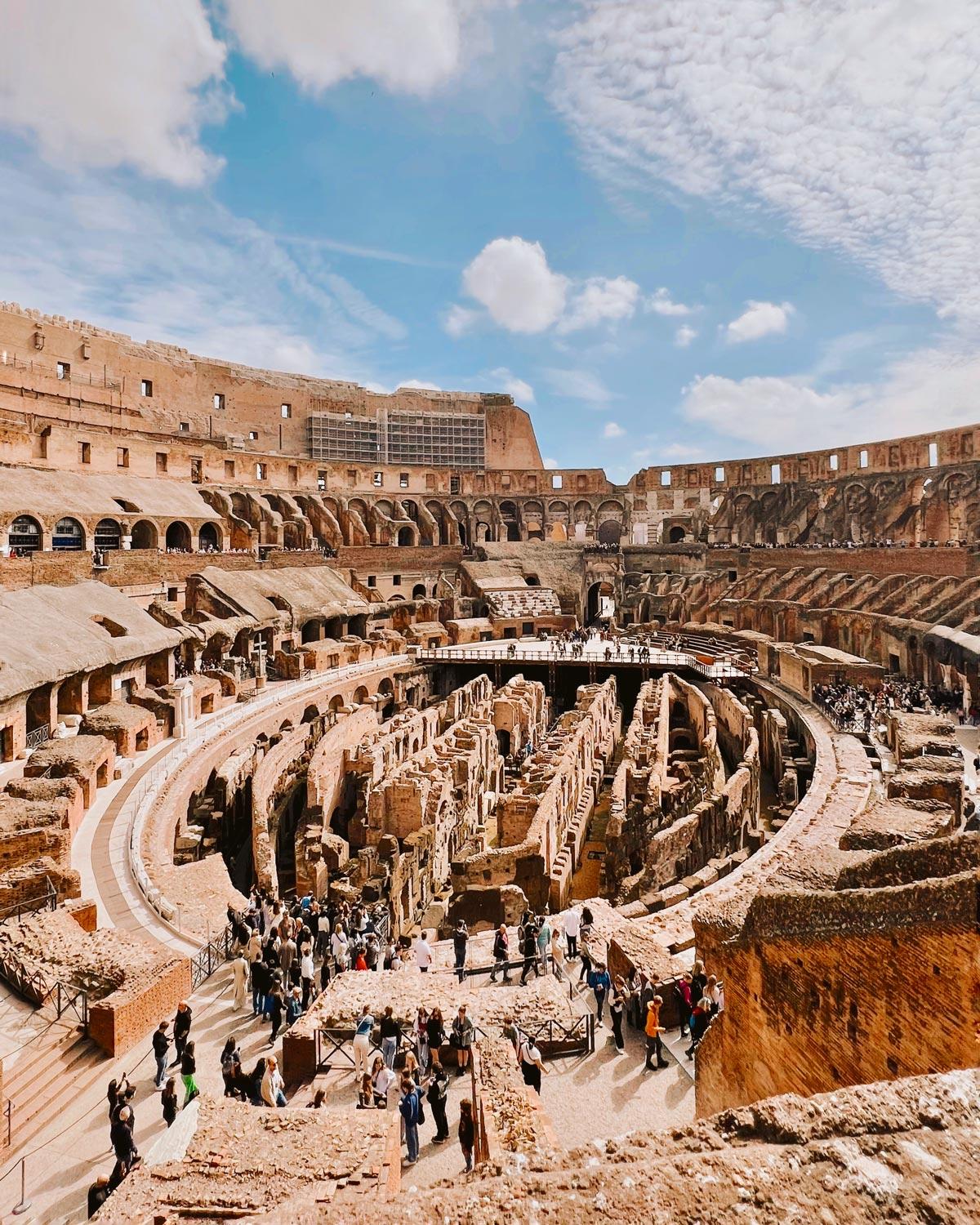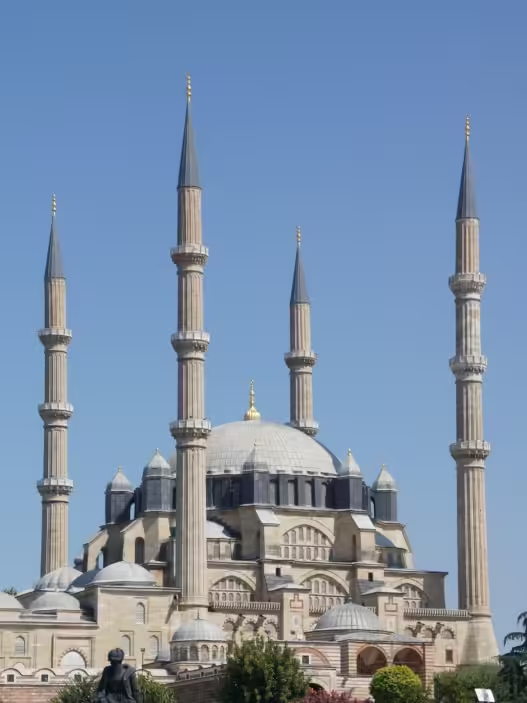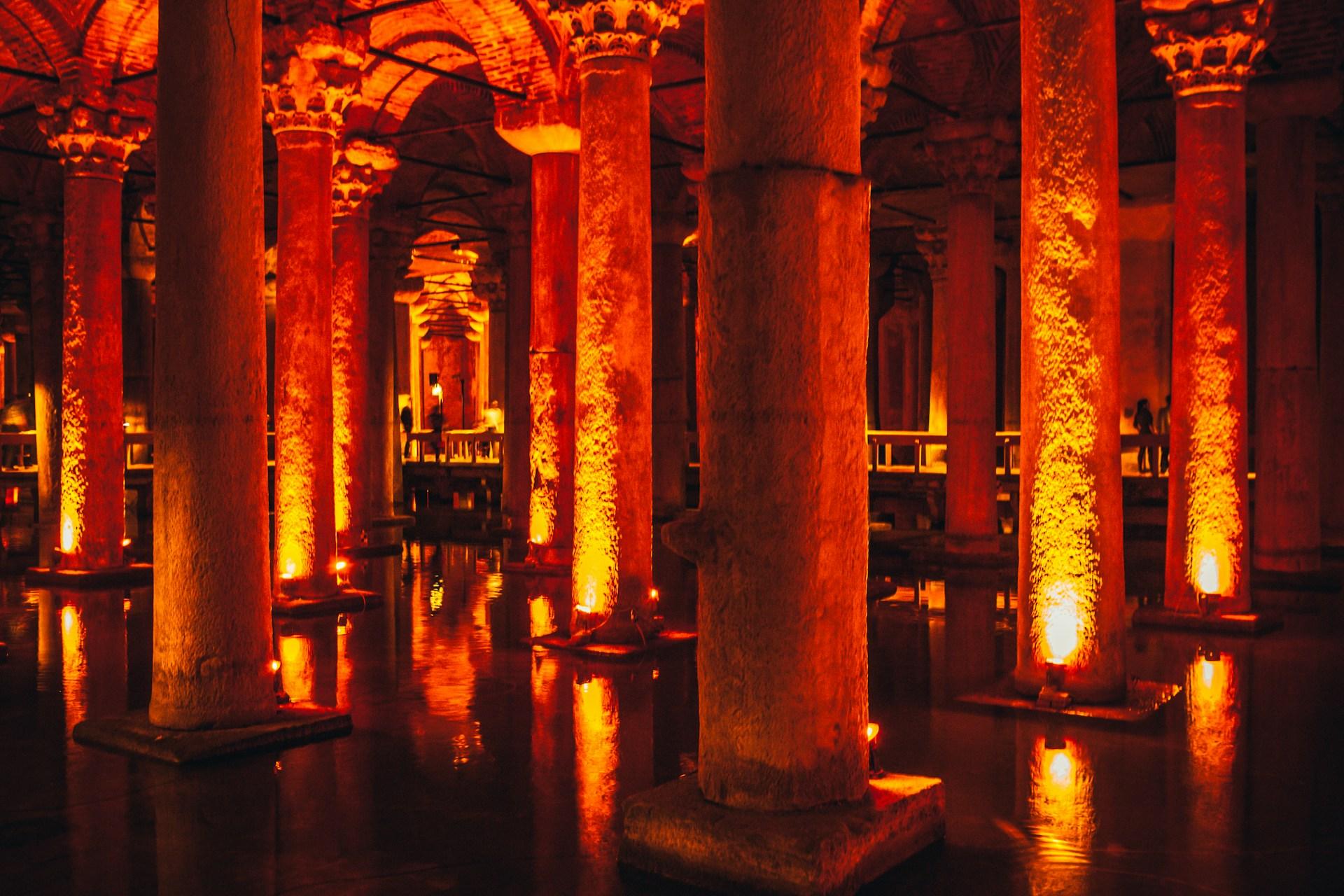One of the most magnificent legacies of the Roman Empire, the Colosseum has survived the depths of history as a towering monument in the center of Rome, the capital of Italy. This fascinating amphitheater is of great historical and architectural significance and is considered a worldwide icon.
- The Colosseum is one of the most magnificent buildings of the Roman Empire and has survived from the depths of history.
- The Roman Forum is an important area that served as a center for various activities, from commerce to worship, and includes many ancient buildings.
- The Circus Maximus was a huge structure used for public games and festivals in Rome and has been expanded and improved over time.
- The Thermal Baths of Caracalla were one of the largest and most luxurious bath complexes of the Roman Empire and served as a center for public bathing and socializing.
- The Basilica of St. Clement is an ancient church dating from the 1st century and has undergone significant changes in different periods.
- The Colosseum is a UNESCO World Heritage Site and is under international protection.
- The Colosseum’s restoration projects aim to repair damaged sections, restore durability to the structure and provide a safe experience for visitors.
- Cultural heritage conservation and educational initiatives aim to pass on the history, structure and significance of the Colosseum to future generations.
- The Colosseum also serves as a venue for various events and performances and special events are organized.
- Visitors to the Colosseum can enjoy an unforgettable experience with tours, special events, souvenirs and photographer services.
Let’s take a closer look at the origins of the Colosseum, its impressive structure and its location…Let’s take a closer look at the origins of the Colosseum, its impressive structure and its location…
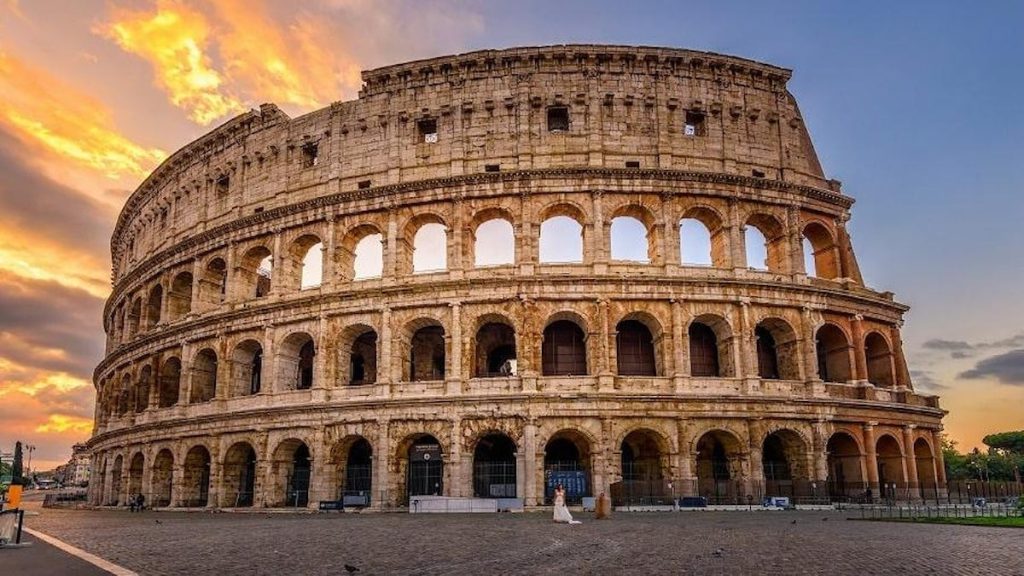
Basic Information About the Colosseum
Built by Emperor Vespasian between 70-80 AD, the Colosseum was used as an amphitheater for gladiator fights, animal hunts and other spectacles held in Rome. The full name of this impressive structure is Flavius Amphitheater. The Colosseum is known as the largest amphitheater in the ancient world, with a capacity of about 50,000 spectators.
The Role of the Colosseum in the Roman Empire
The famous structure played an important role as the entertainment and performance center of the Roman people. Let’s examine the events held in the amphitheater together.
Gladiator Competitions
The Colosseum is known as the site of some of the most famous and well-known gladiatorial fights. Gladiator fights, which were a great source of entertainment for the Roman people for a long time, were held in the Colosseum arena. Gladiators would fight wild animals or other gladiators. The internal structure and circulation of the Colosseum was designed to provide opportunities for such fights.



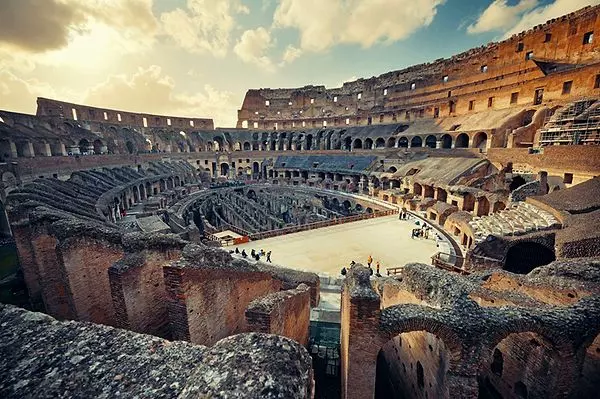

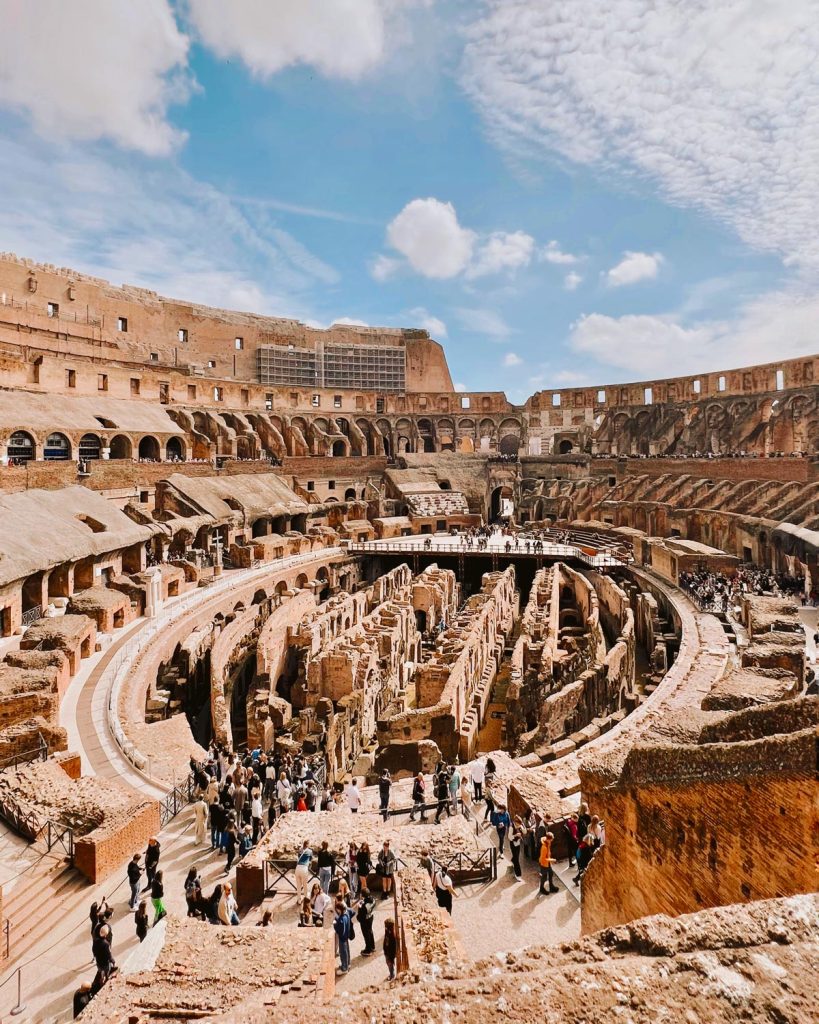

Sea Wars
The Colosseum was one of the few arenas where naval battles could be fought, thanks to specially designed water channels and mechanisms. The center of the arena was filled with water and warships were positioned in this artificial body of water. Such events were rare and were great visual feasts that captivated the Roman public.



Theater and Stage Performances
The Colosseum was also used for theater plays, mythological stage shows and other artistic events. Thanks to its large audience capacity, such events could be watched by many people. The Koleyum was a highly developed amphitheater for the masses to be entertained, with a variety of uses.
Social and Religious Ceremonies
In the Roman Empire, public and religious ceremonies were often held in the Colosseum. Commemorations of important people and rulers, victory celebrations and ceremonies dedicated to the gods were held in this arena.
Symbolic Meaning
The Colosseum has become a symbol of the power and wealth of the Roman Empire. The construction and use of this magnificent structure increased the prestige of the empire and won the satisfaction of the Roman people.
While the Colosseum symbolized the power and wealth of the Roman Empire, it was also part of the empire’s public relations strategies. Performances were offered free of charge to the public and were organized for the amusement and pleasure of the Roman people. This policy, which aimed to help the emperor win the support of the people and ensure the unity of the Roman Empire, was maintained with state support for a long time.
History and Architecture of the Colosseum
Construction History of the Colosseum
The Colosseum is the most important amphitheater built during the Roman Empire. Its construction began in 72 AD and was completed in 80 AD. The construction work started by Emperor Vespasian was completed during the reign of his son Titus after Vespian’s death. The Colosseum is one of the most impressive and famous buildings of the Roman Empire.
Ancient Roman Architecture and Design
The Colosseum is one of the most important examples of Ancient Roman architecture. Designed as a symbol of the wealth and power of the Roman Empire, the Colosseum has a circular form and the exterior of the building was built using travertine stones. The seating inside the amphitheater was constructed using marble blocks so that the audience could sit comfortably. The stones used in the construction of the Colosseum were obtained from local quarries. During the construction process, arches and domes, which are recognized as a great engineering achievement of the period, were used as load-bearing and separating elements in the building.

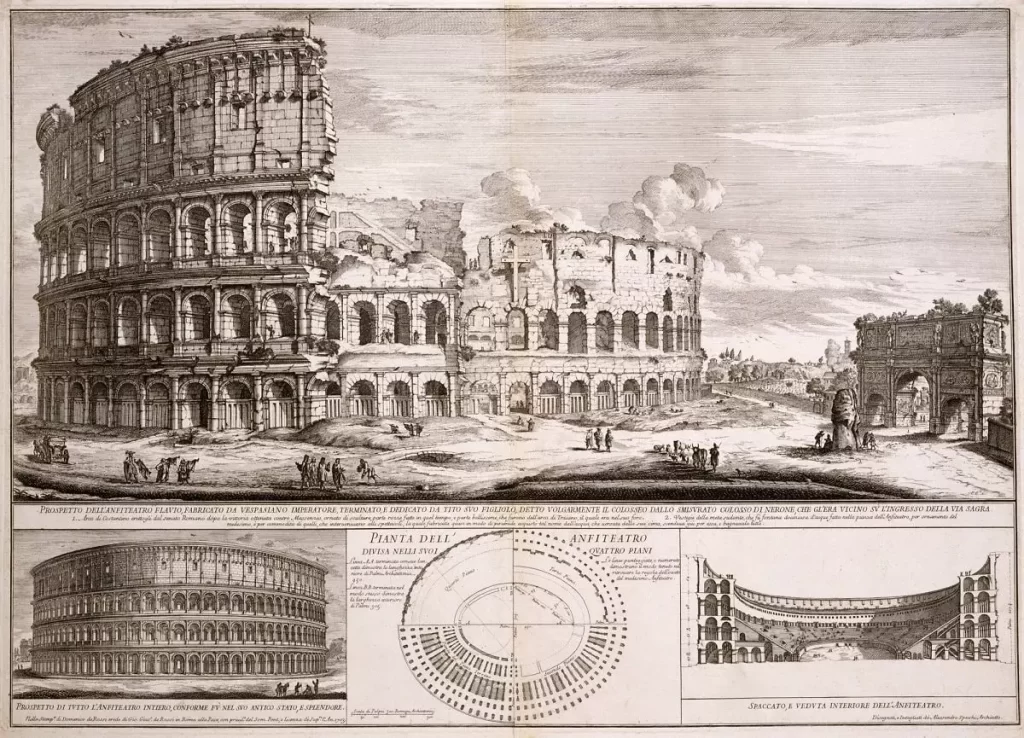





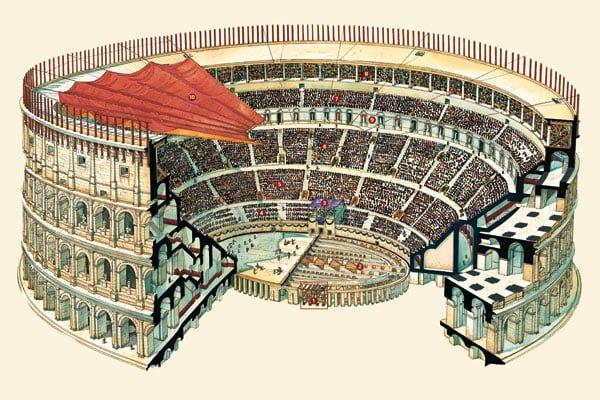

Capacity and Function of the Arena
The Colosseum was designed to have a spectator capacity of 50,000 to 80,000 people. This large capacity allowed the arena to be used for a variety of events. The Colosseum was used for gladiatorial fights, animal hunts, theater plays and other performances. Spectators would come to the arena to watch gladiators fight other gladiators or animals.
Artistic and Architectural Signature
It has a four-storey structure and the seating arrangement inside the building was designed to reflect the distinction between Roman social classes. The Emperor and members of the upper class would sit in the best seats, while lower class citizens and slaves could sit in the upper sections, far from the arena.
The Colosseum is also notable for its ornamentation, like other buildings in the Roman Empire. The walls inside the building are decorated with sculptures, mosaics and frescoes. These decorations reflect the richness and splendor of Roman art.
The Colosseum had specially designed substructures for gladiatorial fights and other spectacles. These underneath the arena allowed the fighters and animals to ascend to the arena. Beneath the impressive structure of the Colosseum visible on the surface, there were various structures such as cellars, slave quarters and animal rooms.
Colosseum Cellars
The cellars of the Colosseum were located under the arena and were used for various purposes. They were used to support performances on the surface of the arena, to store actors and animals, to prepare props, and to provide access to the stage from below the arena. The cellars were connected by tunnels beneath the arena, which made it easier for actors and animals to enter and exit the arena.
Slave Rooms
In ancient Rome, gladiators, warriors or other performing artists were often sold and trained as slaves. The slave quarters in the Colosseum were where these gladiators and other performing artists lived and prepared. In these rooms, they stored their equipment, trained and rested. The slave quarters also allowed the gladiators to make their final preparations before entering the arena and were directly connected to the tunnels beneath the arena.
Animal Chambers
In addition to gladiatorial fights, the Colosseum also hosted shows with wild animals. The animal rooms under the arena were where these wild animals were kept and prepared. Lions, tigers, elephants and other wild animals brought from different parts of the Roman Empire were kept here. During the performance, these animals were brought to the surface of the arena by elevators or ramps.
Arena of the Colosseum
The arena is the central part where events took place. It was used for gladiatorial fights, animal hunts and various other events. The floor of the arena is covered with sand and is equipped with holes to absorb blood during events. Underneath the arena, passages and tunnels allow gladiators and animals to exit the arena.
Interior
The interior of the Colosseum is designed to serve the spectators attending the events. The interior has different sections such as restrooms, restaurants and other service areas. Tunnels and passageways underneath the arena allowed gladiators and animals to exit the arena.
Architectural Influence and Legacy
The Colosseum is one of the most iconic buildings of the Roman Empire and has had a huge impact around the world. Architecturally awe-inspiring in its size and grandeur, the Colosseum is still a major tourist attraction today. The architectural style and design of the Colosseum has inspired many other amphitheaters.
The Colosseum and Entertainment Culture in Ancient Rome
The Colosseum was an important part of the entertainment culture in Ancient Rome. Gladiator fights, animal hunts and other spectacles were events that the Roman people followed with great interest and passion. The shows in the Colosseum were intended to show the public the power and wealth of the Roman Empire.
Gladiator fights were one of the most famous and popular entertainment events of the Roman Empire. As the fighters fought each other in the arena, the public would watch with great excitement. Animal hunts were another spectacle organized in the Colosseum. Exotic animals were displayed in the arena and hunted by hunters.




The Colosseum was also used as a venue for other performances. These included theatrical performances of mythological stories, water fights, horse races and acrobatic shows. These shows provided entertainment and enjoyment for the Roman people, while at the same time showcasing the power and wealth of the empire.
Significance and Impact Today
Today, the Colosseum is still one of Rome’s most important tourist attractions and is visited by millions of tourists annually. Its historical and cultural significance keeps interest in the building alive. It is recognized worldwide as a historical monument and an icon symbolizing the power and wealth of the Roman Empire. As an architecturally impressive building, it has an important place in the history of architecture and art.
Today, the Colosseum also hosts cultural events. Special events, concerts and theater performances take place in the historic atmosphere of the Colosseum. These events breathe new life into the building and offer visitors different experiences. The Colosseum has become an icon for many people, with its historical and cultural significance and its interest in the remains and past of the Roman Empire. Therefore, the importance and impact of the Colosseum today plays a critical role in preserving, understanding and remembering history and culture.
Other Historic Sites Around the Colosseum
The Colosseum is one of the most important architectural monuments of the ancient Roman Empire and one of Rome’s most popular tourist attractions. Other historical sites around the building are also worth exploring. The Colosseum, along with the other ancient buildings around it, forms part of Rome’s historical and cultural heritage. In this area, there are many important buildings that reflect Rome’s rich history and cultural heritage.
Let’s examine a few of these buildings together.
Palatino Hill
According to Roman mythology, the Palatino Hill is known as the place where the lives of Romulus and Remus were saved. Found by a she-wolf, these babies grew up here and Romulus eventually decided to found Rome. The Palatino Hill therefore has an important mythological significance regarding the origins and foundation of Rome.
Historically, the Palatino Hill dates back to the origins of Rome and was inhabited from around 1000 BC. During the Republican period, many wealthy Roman citizens resided in the area and the ruins of the palaces of emperors such as Augustus, Tiberius and Domitian can still be seen. Augustus also built a temple of Apollo in this area.

The Palatino Hill was also home to the Lupercalia festival. This festival was an important part of Roman mythology and culture. Today it is largely used as an open-air museum and visitors can visit it with their tickets for the Colosseum. There are many important ancient ruins and structures in this area. Archaeological excavations on this hill have uncovered prehistoric remains of the Palatino Hill, helping to better understand Rome’s historical and cultural heritage. There is also a museum in the Palatino, which exhibits works of art from the period before the foundation of Rome.
Finally, archaeological work in 2006 and 2007 revealed the remains of a house on the Palatino Hill, considered to be the birthplace of Augustus, and the possible location of the legendary cave of Lupercal.
Roman Forum
The Roman Forum was an important site in the heart of Ancient Rome, serving as a center for a variety of activities including trade, business, worship and socializing. It was a center where the community met and interacted on a daily basis. When we examine the history of the Forum, it is understood that the sediments eroded from the surrounding hills began to raise the level of the forum from the early Republican period, so that this area was originally a marshy ground, but was drained by the Tarquins with the Cloaca Maxima (large sewage system). The travertine sidewalks that can still be observed today in the forum date from the reign of Emperor Augustus.

Structures inside the Forum
The Roman Forum has gained great fame because it gives us a clear picture of urban life in Roman times. This area includes a number of major monuments, structures and ancient ruins:
- Castor Temple
- Temple of Pollux
- Temple of Romulus
- Temple of Saturn
- Temple of Vesta
- Venus and the Roman Temple
- Basilica of Aemilia
- Basilica of Julia
- Arch of Septimius Severus
- Arch of Titus
- Hostilia Court (Curia Hostilia), seat of the Roman Senate.
- Basilica of Maxentius and Constantine
- Tabularium
- Temple of Antoninus and Faustina
- Urbi Belly
- Temple of Caesar
During the decline of the Roman Empire, the Forum was used less for daily business and more for religious ceremonies.
Finally, the Column of Fokas, built in 608 for the Byzantine Emperor Fokas, is the last monument added to the Roman Forum. This monument is a piece that emphasizes the historical and cultural importance of the Forum.
According to an 8th century anonymous traveler from Einsiedeln, the Forum Romanum (Roman Forum) was already crumbling at that time. During the Middle Ages, although the memory of the Forum Romanum survived, the ancient monuments were often buried under ruins and the area between the Capitoline Hill and the Colosseum was known as the “Campo Vaccino” or “cattle pasture”. The return of Pope Urbanus V from Avignon in 1367 contributed to a revival of interest in ancient monuments, partly reflecting moral exhortations and partly used as a reference to the old antiquities compared to the new structures built in Rome over a long period of time. Towards the end of the 15th century, painters began to paint pictures of the ruins in the Forum, in the 16th century antiquarians began to copy inscriptions, and towards the end of the 18th century temporary excavations were begun.
A cardinal took measures by making regulations and establishing the Alessandrine district nearby. It was only in 1803, however, that the excavation by Carlo Fea and excavators under Napoleon, who had begun to expose the debris of the Arch of Septimius Severus, was able to uncover the entrance to the Forum, and was completed in the early 20th century with its complete exposure.
Circus Maximus
Built in the valley between the Aventine and Palatine hills in Rome, it was originally used by the Etruscan kings of Rome for public games and entertainment. The first games were organized here by Tarquinius Priscus, the first Etruscan king of Rome, and these games were later called Ludi Romani (Roman Games). Later, in the 2nd century, the Circus became a center for Greek-influenced folk games and festivals.
Due to the great interest of the Roman people in entertainment, the Circus was expanded by the emperor Julius Caesar in 50 BC. As a result of this expansion, the Circus became approximately 600 meters long, 80 meters wide and had a capacity to accommodate approximately 250,000 spectators. It is estimated that this number of spectators could increase even more with the standing spectators on the surrounding hills. This large structure became an indispensable venue for entertainment events in Rome.
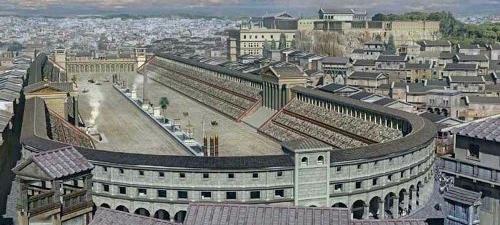
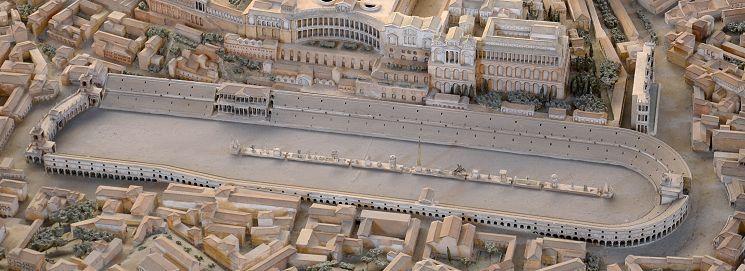

In 81 AD, the Senate commissioned the construction of a three-eyed triumphal arch in honor of the emperor Titus, a special monument to his victories in the East. This triumphal arch is located at the eastern end of the Palatine Hill and should be distinguished from the Arch of Titus on the Via Sacra.
Later, when Emperor Domitian was building his new palace on the Palatine Hill, he ordered to integrate the Circus into this complex to make the races more comfortable to watch. Emperor Trajan, on the other hand, added 5,000 new seats to further improve the Circus and ordered the enlargement of his throne to make it more visible to spectators. These changes show the continuous development and reorganization of these important structures in Rome’s history.
Chariot races were among the most important events organized in the Circus. The track could accommodate twelve chariots and was divided in the center by a central elevation, the “spina”. The spina was partly diagonal and had statues of different gods on it. Next to it was a statue of Augustus on an Egyptian obelisk. At the end of the Spina was the “meta”, a turning point where the cars spun rapidly and the competition intensified. The rotatable metal dolphins at the top of the Spina were flipped down to show the number of laps of the race.
Car races were very dangerous because they often led to spectacular accidents and could result in the death of one or more drivers. One side of the track was wider than the other to allow cars to start side by side. This section was intended to minimize accidents while allowing all cars to proceed in the same direction and equidistant from the first turning point.
Little is known about other parts of the Circus other than the grass-covered race track. Although parts of the starting gate have survived, most of the seats have been destroyed and were used as building materials in medieval Rome.
Thermal Baths of Caracalla
Located a little further away from the Colosseum, the Thermal Baths of Caracalla is a large thermal bath complex built by the Roman Emperor Caracalla. These baths are known as the largest and most luxurious thermal baths of the Roman Empire.

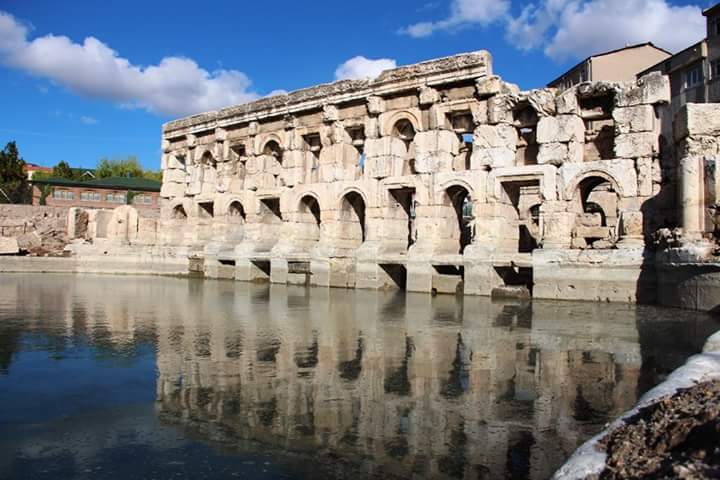

- Public Cleansing Centers: Roman baths functioned as public bathing and socializing centers. These baths, located in most Roman cities, were used for Roman citizens to clean and rest.
- Water Use: The water used in Roman baths was usually transported from the water source to the baths with the help of aqueducts. The water engineering systems of the Roman Empire were very effective for the water supply of the baths.
- Part of Daily Life: In Roman times, baths were an integral part of daily life. The wealthy Romans made it a habit to go to the baths every day. This was not only an opportunity to get clean, but also to socialize and exercise.
- Sports and Exercise: Romans often practiced sports as part of the baths. Sports activities such as running, weight lifting and wrestling were common in the baths. After these activities, bathhouse visitors would proceed to oil application and skin cleansing.
- Body Cleansing: In the baths, body cleansing was done with a tool called strigilis. Strigilis helped to remove sweat, sand and dust adhering to the body. The body was then oiled in an area called the aleipterion.
- Social Activities: The baths were also a tool for social interaction. People would meet their friends here, chat and spend their time.
- Design and Architecture: Roman baths were designed by famous architects of the period. Vitruvius‘ “De architectura” contains detailed information about the design of the baths.
- Help of Slaves: Rich Romans usually came to the baths with slaves who served them. These slaves undertook tasks such as carrying towels and drinks.
Roman baths formed an important part of the Roman Empire, both in terms of physical cleanliness and social interaction. They were also of great importance as a demonstration of Roman architecture and water engineering skills.
Basilica of St. Clement
The Basilica of St. Clemente is an ancient church with a rich history in Rome. This church dates back to the 1st century and has undergone significant changes at various periods in time.


We can summarize the history of St. Clemente Basilica in 4 stages:
Pre Antiquity
The lowest floors of the Basilica of St. Clemente contain the remains of the foundations of a building that probably dates back to the Roman Republic. This building is thought to have been destroyed in the Roman fire known as the Great Fire.
Mithraeum Period (ca. 200 AD)
Around 200 AD, a mithraeum, the sanctuary of the cult of Mithras, was built on this site. This Mithras temple included important elements such as a sarcophagus-shaped altar and a tauroctoni relief.
Early Christian Period (4th century)
In the 4th century, the industrial building on this site was reorganized and the lower floor was filled with earth and rubble. The second floor was reorganized and used as the first basilica. The first basilica was dedicated to St. Clement and is known as a Christian church recorded by St. Jerome.
Middle Ages and Restoration (4th – 11th century)
Built in the 4th century, the first basilica underwent various restorations over time. In the 9th century and between 1080-99, work was carried out on the basilica.
Councils and the Election of Popes
Throughout its history, the first basilica hosted councils presided over by Popes Zosimus (417) and Symmachus (499). It also witnessed the election of Cardinal Rainerius as Pope Paschal II in 1099.
The Basilica of San Clemente serves as an important historical and archaeological site that carries the traces of the past to the present. This church, which sheds light on the early Christian era and the history of the Roman Empire, offers visitors a unique experience.
The large frescoes in the basilica were financed by Beno de Rapiza and Maria Macellaria towards the end of the 11th century. These frescoes focus on the life, miracles and translation of St. Clement. The life of St. Alexios is also included. Beno and Maria are depicted on the façade of the basilica with their children Altilia and Clemens. There is also a scene depicting a miracle performed by St. Clement on the column on the left side of the basilica.
A particularly striking detail in these frescoes is that they contain an early example of the transition from Latin to vernacular Italian. Below the fresco is a scene in which the pagan Sisinnius and his servants think they have captured St. Clement, but instead drag a pillar. Sisinnius is depicted encouraging his servants in Italian.
Art historians have long thought of Beno de Rapiza and Maria Magellaria as supporters of the reform popes Gregory VII, Urban II and Paschal II and that these frescoes were reform party propaganda. However, if the frescoes are dated to the 1080s or 1090s, it is possible that Beno and Maria were actually trying to honor the first Christian pope of this period, the Antipope Clement III (Wibert of Ravenna), rather than the reform party. He had the same name as a second Saint Clement.
These frescoes are of great historical and artistic importance and offer visitors the opportunity to understand the cultural and religious atmosphere of this period.
Gladiator Fights and Entertainment
The Origins of Gladiatorial Fights at the Colosseum
Gladiator fights are known as the most famous and popular entertainment of the Roman Empire. The origins of gladiatorial fights date back to the 3rd century BC. There are many different theories and opinions about the origin of gladiators and fights. Some of the views that are accepted today are as follows:
- Etruscan Origin Some early Roman writers argued that gladiators were of Etruscan origin. The Etruscans were an important civilization in ancient Italy.
- Samnite Origin Some ancient writers, such as Livy, attributed the origin of gladiatorial combat to the Samnite wars. According to this theory, the Romans started gladiatorial games to honor the memory of enemy warriors killed fighting the Samnites.
- Campania Influence: The region of Campania may have played an important role in the early gladiatorial tradition. Evidence, such as the funerary frescoes from Paestum, suggests that this region may have contributed to the early stages of gladiatorial games.
The history of gladiators is complex and is thought to have evolved with the changing needs of ancient Roman society and cultural developments. Gladiators were armed warriors, known as armed combatants, who provided a visual feast for spectators in arenas during the Roman Republic and Roman Empire. These warriors were trained to engage in a variety of violent confrontations in the arena with other gladiators, wild animals and condemned criminals. Gladiatorial fights became a great pastime and popular in Roman society.
- Origins and Training: Contrary to popular belief, gladiators were multinational. While some volunteer gladiators voluntarily chose to fight in the arenas, most gladiators were social outcasts, such as slaves, prisoners of war or criminal convicts. Their training took place in gladiator schools (ludus). Here students were taught martial arts, the use of weapons and survival skills.
- Social Status Gladiators were considered to have a low social status in Roman society. However, some successful gladiators were able to gain wealth and fame through their popularity and skill.
- Fighting Styles: Gladiator fights involved different combinations of weapons and armor. Retiarius was armed with a net and a triple-edged spear, while Secutor was equipped with heavy armor and a shield against the net and spear. These different fighting styles offered viewers a variety of visual experiences.
- Popularity and Honor: Gladiators won the admiration of spectators when they successfully fought or died in the arena. Their bravery and fighting skills were admired in Roman society. Popular gladiators gained a large following and won great prizes
- Religious and Social Meaning: Gladiatorial fights played an important religious and social role in Roman society. They were especially organized at funerals of the dead or special festivals. Gladiators were also seen as figures representing Roman military virtues and martial ethics.
- Popularity and Cost: Gladiatorial fights became increasingly popular and cost a great deal of money to organize. Wealthy Roman citizens organized gladiatorial fights in order to gain prestige in society by organizing arenas and games in their name.








The Social and Cultural Role of Gladiatorial Fights
Gladiatorial fights played a major social and cultural role in Roman society. These fights provided entertainment for the people and were also used as an opportunity to showcase the power and wealth of the empire. The fights held in the Colosseum became a major event of the Roman Empire and brought people together.
The development of gladiatorial games evolved depending on the political, social and cultural dynamics of ancient Roman society. We can list the important stages of its development in 5 points
- Early Munus: The first gladiatorial games are known as private munus. These games were often organized by rich and influential people. These performances, associated with commemoration of the dead or religious rituals, began early in the Roman Empire.
- Celebrations of Military Victories: Some munus were organized as part of victory celebrations. Especially after major military victories, gladiatorial games were organized to celebrate the victory and entertain the public.
- Expansion outside Rome: Gladiatorial games spread beyond the borders of the Roman Empire. The adoption of these games by the Iberian allies shows how gladiatorial culture reached regions far from Rome in the early period.
- State Sponsored Games: In 105 BC gladiatorial fights were brought to Rome as part of army training and gained great popularity. Later these fights were incorporated into the ludi, the state games.
- Religious and Divine Munus: Gladiatorial games became part of state games, sometimes dedicated to gods or heroic ancestral figures. This suggests that the games acquired a religious dimension.
The evolution of gladiatorial fights was shaped as a reflection of the period of Roman society. Used as both entertainment and political propaganda, these shows were organized for different purposes in various periods of the Roman Empire.
In order to examine the development and effects of gladiatorial games in the Roman Empire in more detail, we would like to analyze the games period by period:
Early Periods
- The games organized by the Campanians in 310 BC are an early example of gladiatorial games.
Empire and Control
- Under Augustus, the gladiatorial games were formalized and controlled by the empire. This decision is interpreted as a sign of the increasing centralized authority of the empire.
- Gladiatorial games became an important tool used by emperors to publicize themselves and gain approval.
Political Propaganda Tools
- Gladiator games were an effective propaganda tool for political figures. Using these games, especially during election seasons or during periods of ascension to important positions for politicians, was considered a way to increase popularity.
- Julius Caesar tried to promote his political career by organizing the dolphin games for his father.
Social Power and Aristocrats
- Gladiators became a tool for political power, especially in the late Republican period. Wealthy aristocrats tried to gain influence in society by financing gladiators.
- By financing the deaths of gladiators, these aristocrats demonstrated their generosity in the eyes of the public.
Public Entertainment and Community Support
- In Rome, it was important to gain and maintain public support. The great gladiatorial games entertained the public and at the same time gave political figures the opportunity to curry favor with the public.
- The public showed great interest in these performances, which were free of charge.
Cost and Legal Regulations
- Gladyatör oyunlarının maliyeti, politika ve ekonomi açısından önemli bir faktördü. Bu oyunlar için harcamalar zaman zaman sorunlu hale geldi.
- İmparatorlar, maliyeti kontrol altına almak ve gladyatör munera’sını sınırlamak için yasal düzenlemeler getirdi.
İmparatorluk Kültü ile İlişkilendirilme
- Emperors used the gladiatorial games as part of the imperial cult to elevate their own divine status.
- These games increased public recognition, respect and approval of the emperors.
Dissemination of Games
- Gladiatorial games spread throughout the Roman Empire. They were adopted in different parts of Rome and interacted with different cultures.
End Period and Decline
- In the 2nd and 3rd centuries AD, gladiatorial games declined with economic and social changes. Emperors restricted these spectacles more frequently.
- By the 5th century AD, the gladiatorial games were almost completely over.
The decline of the gladiatorial games has been a complex process of historical and cultural changes in the Roman Empire.
Economic Factors
- The Roman Empire began to face economic difficulties at the beginning of the 3rd century AD. Defense and military expenditures on the borders of the empire increased. Therefore, it became difficult for the empire to finance the gladiatorial games.
Military Repression
- Rome needed more resources to cope with barbarian invasions and other military problems. This led to the limitation of funding for gladiatorial games.
The Rise of Christianity
- As Christianity became more and more widespread in the Roman Empire, Christians saw the gladiatorial games as violent and idolatrous and refused to participate in them. This affected the popularity of the games.
Regulation and Control
- Emperors tried to control the gladiatorial games. Legislation was introduced to limit costs and improve the situation of gladiators.
Change in Public Interest
- Over time, people’s entertainment preferences changed. The interest in gladiatorial games waned and people turned to different forms of entertainment.
Imperial Cult and Deification
- Emperors used the gladiatorial games to elevate their own divine status and strengthen the imperial cult in the eyes of the people. But this did not prevent the games from declining.
Anti-Christianity and Prohibition
- Christian leaders criticized gladiatorial games and encouraged Christians to avoid such events. Theodosius I banned pagan festivals and put an end to gladiatorial games.
Intra-Imperial Instability
- The internal instability of the Late Roman Republic and Empire also hastened the end of the gladiatorial games. Political conflicts between aristocrats and the division of the empire characterized this period.
The Popularity and Controversy of the Colosseum Fights
Colosseum fights were hugely popular with the Roman people. People flocked to the Colosseum to watch the gladiators fight each other. But with the popularity of the fights came controversy. The Colosseum fights were seen as an event where many people were mistreated, slaves were brutally killed and animals were brutalized. This controversy was one of the factors that led to the end of the fights.
The End of the Colosseum Fights
Emperor Theodosius I banned colosseum fights altogether in 393 AD. This decision was taken in conjunction with the adoption of Christianity as the official religion and marked the end of colosseum fights. The Colosseum was then used for other purposes, but the fights were no longer held.
Revival and Popularity of the Colosseum
Over the long time since its construction and glory days, the Colosseum’s popularity has declined and the structure has suffered serious damage. In recent years, the Colosseum has seen a revival and an increase in popularity. But the building’s journey to the present day has not been easy. Over the years it has been damaged and partially destroyed by earthquakes, wars and looting. However, it has been restored and preserved, allowing future generations to see and experience this historic structure.
The Revival of the Colosseum
Restoration Works
A series of restoration works were carried out to revitalize the Colosseum. First, damaged and decayed parts of the structure were identified and restored. These works were carried out to preserve the original appearance of the Colosseum and provide a safe experience for visitors.
Financing
Financing the restoration work was a major problem. However, the Italian government, private companies and international organizations provided significant funds to support the project. In addition, revenues from tourism revenues were also used for the revitalization of the Colosseum.
Impacts of the Revitalization
The revitalization of the Colosseum has been a major boost to Rome’s tourism industry. Following the completion of the restoration work, interest in the Colosseum has grown and visitor numbers have increased significantly. This has had a positive impact on Rome’s economy, increasing job opportunities and income for local businesses.





Popularity of the Colosseum
Historical and Cultural Importance
The Colosseum has great historical and cultural significance as one of the symbols of the Roman Empire. A testament to the architectural and engineering skills of ancient Rome, it is of great interest around the world.
Tourist Attraction
The Colosseum is one of Rome’s most popular tourist attractions. Visitors flock here to visit this ancient building, learn about its history and experience the atmosphere of that period. The Colosseum is a place for tourists to make unforgettable memories.
Popularity in Film and Television
The Colosseum has been featured in many famous movies and television series, increasing interest in the building. For example, movies such as Gladiator have highlighted the Colosseum and increased admiration for the building. This has contributed to the spread of the Colosseum’s popularity around the world.
Inclusion of the Colosseum on the World Heritage List
Recognition by UNESCO
The Colosseum was inscribed on the World Heritage List by UNESCO in 1980. This honors the building as a cultural heritage of worldwide recognition and protection. The inscription of the Colosseum on the World Heritage List provides an international commitment to protect and preserve the building for future generations.
Conservation Efforts
The Colosseum has World Heritage status and requires special protection and care. The Italian government and other relevant organizations regularly carry out maintenance and restoration work to protect the Colosseum. These works are carried out to protect the building from future damage and to ensure a safe experience for visitors.
Cultural Heritage Protection
The Colosseum is not only a historic building, but also an important symbol of Rome and world culture. World Heritage status is an important step to protect the building and pass on its cultural heritage to future generations. This will ensure that the Colosseum’s popularity and importance will continue for years to come.
The future of the Colosseum and conservation efforts
Restoration Efforts of the Colosseum
The Colosseum has been damaged by various natural disasters, wars and destructions in the past. However, thanks to restoration efforts over time, parts of the Colosseum have been preserved to this day. In the 18th and 19th centuries, restoration efforts reopened parts of the Colosseum and opened it to tourists. Today, the Colosseum is still one of Rome’s most popular tourist attractions, offering visitors the opportunity to go back to one of the glorious periods of the Roman Empire.
Preservation and Restoration Projects of the Colosseum
The Colosseum is one of the most iconic buildings of the Roman Empire and an important part of the world cultural heritage. However, over time it has been damaged by various factors and is in need of restoration. In this section, we will learn more about the conservation and restoration projects of the Colosseum.
Although the Colosseum was built in the 2nd century, over time it has suffered serious damage due to earthquakes, environmental factors and human intervention. However, authorities and experts have carried out various restoration projects to preserve the historical and cultural value of the Colosseum.
Restoration projects aim to repair damaged parts of the Colosseum, to give the structure durability and to ensure safe access for visitors. These projects are carried out by specialized teams of architects, engineers and historians.
However, during restoration projects, the texture and features of the original structure are preserved, while ensuring compliance with modern safety standards. The restoration process requires meticulous research and analysis and aims to use original materials and to make the restoration as authentic as possible.
Cultural Heritage Preservation and Education Initiatives
The preservation of the Colosseum is not limited to physical restoration projects. Cultural heritage conservation also includes education and awareness initiatives. Various educational programs and events are organized to provide information about the historical and cultural significance of the Colosseum and to pass it on to future generations.
These initiatives aim to familiarize local residents, visitors and students with the history, structure and significance of the Colosseum. These programs are carried out through guided tours, workshops, seminars and other events.
There are also various campaigns for the preservation and sustainability of the Colosseum. These campaigns aim to raise funds for the restoration of the Colosseum, while at the same time reducing tourism and environmental impacts that could damage the building.
Future Uses and Purposes of the Colosseum
The Colosseum is not only a historical monument, but is also used for various purposes. Today, the Colosseum serves as a venue for cultural events, concerts, exhibitions and other events. It also plays a major role in the tourism sector, welcoming millions of visitors every year.
In the future, the use and purposes of the Colosseum will be shaped in a way that advances cultural heritage protection and sustainability. The Colosseum will continue to be a tourist attraction, maintaining its historical and cultural significance.
Colosseum Visitor Experience
Colosseum Visitor Information and Tickets
The Colosseum welcomes millions of visitors a year. Visitors must purchase tickets to visit the Colosseum. Tickets can usually be purchased in advance online or at the ticket office at the entrance of the Colosseum.
Visitors to the Colosseum are also provided with some important information. Visitors to the Colosseum should follow the appropriate dress code and bring the necessary items such as sun protection, water and comfortable shoes.
Self-Guided Tours of the Colosseum
Visitors to the Colosseum can explore the Colosseum on self-guided tours. These tours use audio guides or mobile apps to provide visitors with information about the history and architecture of the Colosseum. Visitors can move around at their own pace and focus on points of interest.
Self-guided tours are a popular option to avoid crowds at the Colosseum and give visitors more freedom. Visitors can plan their tours in advance and reduce waiting times by purchasing tickets in advance.
Special Events and Shows
The Colosseum regularly hosts special events and performances. These include concerts, theater plays, art exhibitions and night tours. These events are organized to offer a different experience in the historic atmosphere of the Colosseum.
Special events and shows usually require a separate ticket and it is recommended to purchase tickets in advance. These events are a popular option to offer a unique experience in the atmosphere of the Colosseum and give visitors the opportunity to experience Rome’s history more closely.
Souvenirs and Memories
Visitors to the Colosseum can buy souvenirs as a souvenir of their visit to the Colosseum. Near the Colosseum, visitors will find a variety of souvenir shops and vendors. These shops offer Roman-themed souvenirs, historical replicas and other products related to the Colosseum.
Visitors can also take souvenir photos during their visit to the Colosseum. Around the Colosseum, there are also professional photographers who offer photo shoot services to visitors. These photographers allow visitors to have a professional photo taken in front of or inside the Colosseum and help them immortalize their memories.
Other Services Offered to Colosseum Visitors
Other services offered to Colosseum visitors include tour guiding services, restaurants and cafes. Professional guides offering tour guiding services at the Colosseum explain the history and important details of the Colosseum to visitors, making their visit more informative.
Near the Colosseum, there are also restaurants and cafes where visitors can relax and eat. These places offer visitors the opportunity to relax and enjoy Roman cuisine.
Things to consider when visiting the Colosseum
There are some points to be considered when visiting the Colosseum. First of all, it is important to follow the security rules in the Colosseum area. Visitors must pass through the security check and follow the instructions of the security guards.
During the visit, visitors are expected to respect the environment and the historical building. It should be remembered that the Colosseum is a historical building and should be protected. Visitors should not litter, write on the walls or damage historical artifacts in the Colosseum.
Visitors to the Colosseum should be aware of long queues and crowds at peak times. The Colosseum can be especially crowded during the tourist season and on weekends. It is therefore advisable to plan the time of visit in advance and buy tickets in advance.
Frequently Asked Questions
- What is the Colosseum?
- The Colosseum is a large amphitheater built in ancient Rome. It was used for gladiator fights, animal hunts and other spectacles.
- Where is the Colosseum?
- The Colosseum is located in Rome, the capital of Italy. It is located southeast of the city center, next to the Roman Forum.
- What is the history of the Colosseum?
- The Colosseum was built between 70-80 AD by the Roman Emperor Vespasian. It was completed between 80-96 AD during the reign of Emperor Titus, Vespasian’s son.
- What are the materials used in the construction of the Colosseum?
- Materials such as travertine stone, brick and concrete were used in the construction of the Colosseum. It is a very robust structure according to the architectural techniques of the period.
- What was the Colosseum used for?
- The Colosseum was often used for gladiatorial fights, animal hunts, dramatic performances and other public events. It served as a center of entertainment and spectacle for the Roman people.
- Why was the Colosseum built?
- The Colosseum was built to entertain the Roman people and increase the popularity of the emperors who ruled them. It was also considered a symbol of imperial power.
- What are the dimensions of the Colosseum?
- The Colosseum is 189 meters long, 156 meters wide and about 50 meters high. The three-story structure can hold approximately 50,000-80,000 people.
- What kind of events are organized at the Colosseum?
- Today, the Colosseum hosts tourist visits, special events, concerts, film screenings and other cultural events.
- How to get to the Colosseum?
- Since the Colosseum is located in the center of Rome, it is easily accessible via the city’s transportation network. It can be reached by public transportation such as metro, bus and taxi.
- Do you need a ticket to visit the Colosseum?
- Yes, it is usually necessary to buy a ticket to visit the Colosseum. However, privileged access can be granted for some special events or tours.
My thoughts about the Colosseum
The Colosseum is an enormous structure that stands as a majestic symbol of the Roman Empire. This ancient amphitheater is a great feat of stonework and engineering. Each tier is designed to accommodate thousands of spectators and is remarkable for its size and functionality. As a monument reflecting the historical and cultural richness of Rome, the Colosseum also has a fascinating significance as a symbol that keeps alive a memory of the past and civilization. For this reason, the Colosseum is one of those rare structures that combine human engineering skill with historical depth and certainly deserves this special place.
What do you think about the Colosseum? Do you think this magnificent structure deserves to be the main stage for the most important events of its time? Are you impressed by its architectural design and what it offers to its visitors? If you haven’t checked it out yet, you can read our review of the Waterfall House, one of the most important architectural works, here.
Mimar: Bilinmiyor
Mimari Tarz: Antik Roma Mimarisi
Yıl: M.S. 70-80
Yer: Roma, İtalya
Discover more from Dök Architecture
Subscribe to get the latest posts sent to your email.








